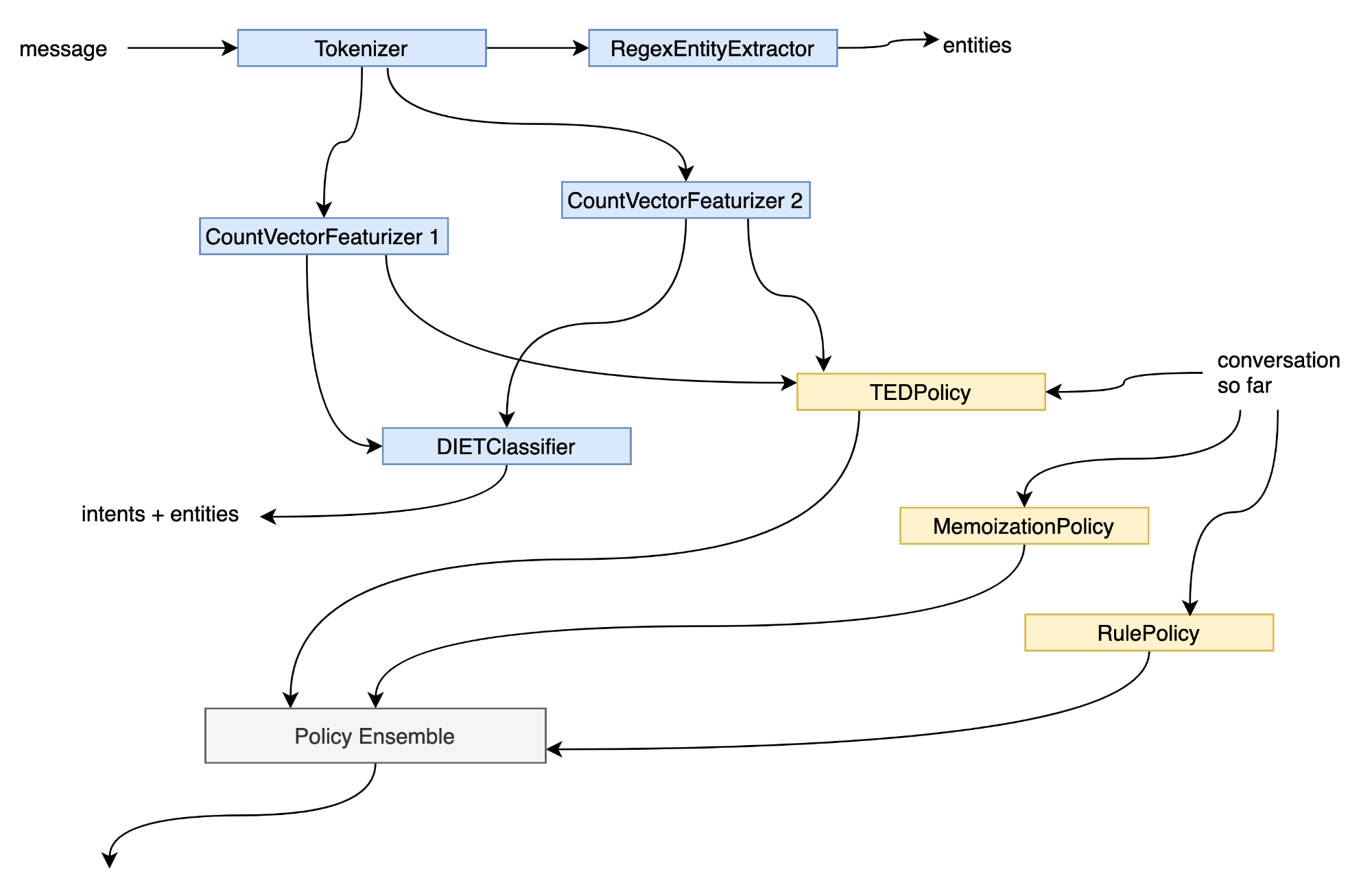可以使用自定义NLU组件和策略扩展Rasa,本文提供了如何开发自己的自定义Graph Component指南。
Rasa提供各种开箱即用的NLU组件和策略。可以使用自定义Graph Component对其进行自定义或从头开始创建自己的组件。
要在Rasa中使用自定义Graph Component,它必须满足以下要求:
-
它必须实现GraphComponent接口 -
必须注册使用过的model配置 -
必须在配置文件中使用它 -
它必须使用类型注释。Rasa利用类型注释来验证模型配置。不允许前向引用。如果使用Python 3.7,可以使用 from __future__ import annotations来摆脱前向引用。
一.Graph Components
Rasa使用传入的模型配置(config.yml)来构建DAG,描述了config.yml中Component间的依赖关系以及数据如何在它们之间流动。这有两个主要好处:
-
Rasa可以使用计算图来优化模型的执行。这方面的例子包括训练步骤的高效缓存或并行执行独立的步骤。 -
Rasa可以灵活地表示不同的模型架构。只要图保持非循环,Rasa理论上可以根据模型配置将任何数据传递给任何图组件,而无需将底层软件架构与使用的模型架构绑定。
将config.yml转换为计算图时,Policy和NLU组件成为该图中的节点。虽然模型配置中的Policy和NLU组件之间存在区别,但当它们被放置在图中时,这种区别就被抽象出来了。此时,Policy和NLU组件成为抽象图组件。在实践中,这由GraphComponent接口表示:Policy和NLU组件都必须继承此接口,才能与Rasa的图兼容并可执行。

二.入门指南
在开始之前,必须决定是实现自定义NLU组件还是Policy。如果正在实现自定义策略,那么建议扩展现有的rasa.core.policies.policy.Policy类,该类已经实现了GraphComponent接口。如下所示:
fromrasa.core.policies.policyimportPolicy
fromrasa.engine.recipes.default_recipeimportDefaultV1Recipe
#TODO:Correctlyregisteryourgraphcomponent
@DefaultV1Recipe.register(
[DefaultV1Recipe.ComponentType.POLICY_WITHOUT_END_TO_END_SUPPORT],is_trainable=True
)
classMyPolicy(Policy):
...
如果要实现自定义NLU组件,要从以下框架开始:
fromtypingimportDict,Text,Any,List
fromrasa.engine.graphimportGraphComponent,ExecutionContext
fromrasa.engine.recipes.default_recipeimportDefaultV1Recipe
fromrasa.engine.storage.resourceimportResource
fromrasa.engine.storage.storageimportModelStorage
fromrasa.shared.nlu.training_data.messageimportMessage
fromrasa.shared.nlu.training_data.training_dataimportTrainingData
#TODO:Correctlyregisteryourcomponentwithitstype
@DefaultV1Recipe.register(
[DefaultV1Recipe.ComponentType.INTENT_CLASSIFIER],is_trainable=True
)
classCustomNLUComponent(GraphComponent):
@classmethod
defcreate(
cls,
config:Dict[Text,Any],
model_storage:ModelStorage,
resource:Resource,
execution_context:ExecutionContext,
)->GraphComponent:
#TODO:Implementthis
...
deftrain(self,training_data:TrainingData)->Resource:
#TODO:Implementthisifyourcomponentrequirestraining
...
defprocess_training_data(self,training_data:TrainingData)->TrainingData:
#TODO:Implementthisifyourcomponentaugmentsthetrainingdatawith
#tokensormessagefeatureswhichareusedbyothercomponents
#duringtraining.
...
returntraining_data
defprocess(self,messages:List[Message])->List[Message]:
#TODO:ThisisthemethodwhichRasaOpenSourcewillcallduringinference.
...
returnmessages
下面会介绍如何解决上述示例中的TODO,以及需要在自定义组件中实现的其它方法。
自定义词法分析器:如果创建了一个自定义的tokenizer,应该扩展rasa.nlu.tokenizers.tokenizer. Tokenizer类。train和process方法已经实现,所以只需要覆盖tokenize方法。
三.GraphComponent接口
要使用Rasa运行自定义NLU组件或Policy,必须实现GraphComponent接口。如下所示:
from__future__importannotations
fromabcimportABC,abstractmethod
fromtypingimportList,Type,Dict,Text,Any,Optional
fromrasa.engine.graphimportExecutionContext
fromrasa.engine.storage.resourceimportResource
fromrasa.engine.storage.storageimportModelStorage
classGraphComponent(ABC):
"""Interfaceforanycomponentwhichwillruninagraph."""
@classmethod
defrequired_components(cls)->List[Type]:
"""Componentsthatshouldbeincludedinthepipelinebeforethiscomponent."""
return[]
@classmethod
@abstractmethod
defcreate(
cls,
config:Dict[Text,Any],
model_storage:ModelStorage,
resource:Resource,
execution_context:ExecutionContext,
)->GraphComponent:
"""Createsanew`GraphComponent`.
Args:
config:Thisconfigoverridesthe`default_config`.
model_storage:Storagewhichgraphcomponentscanusetopersistandload
themselves.
resource:Resourcelocatorforthiscomponentwhichcanbeusedtopersist
andloaditselffromthe`model_storage`.
execution_context:Informationaboutthecurrentgraphrun.
Returns:Aninstantiated`GraphComponent`.
"""
...
@classmethod
defload(
cls,
config:Dict[Text,An服务器托管网y],
model_storage:ModelStorage,
resource:Resource,
execution_context:ExecutionContext,
**kwargs:Any,
)->GraphComponent:
"""Createsacomponentusingapersistedversionofitself.
Ifnotoverriddenthismethodmerelycalls`create`.
Args:
config:Theconfigforthisgraphcomponent.Thisisthedefaultconfigof
thecomponentmergedwithconfigspecifiedbytheuser.
model_storage:Storagewhichgraphcomponentscanusetopersistandload
themselves.
resource:Resourcelocatorforthiscomponentwhichcanbeusedtopersist
andloaditselffromthe`model_storage`.
execution_context:Informationaboutthecurrentgraphrun.
kwargs:Outputvaluesfrompreviousnodesmightbepassedinas`kwargs`.
Returns:
Aninstantiated,loaded`GraphComponent`.
"""
returncls.create(config,model_storage,resource,execution_context)
@staticmethod
defget_default_config()->Dict[Text,Any]:
"""Returnsthecomponent'sdefaultconfig.
Defaultconfiganduserconfigaremergedbythe`GraphNode`beforethe
configispassedtothe`create`and`load`methodofthecomponent.
Returns:
Thedefaultconfigofthecomponent.
"""
return{}
@staticmethod
defsupported_languages()->Optional[List[Text]]:
"""Determineswhichlanguagesthiscomponentcanworkwith.
Returns:Alistofsupportedlanguages,or`None`tosignifyallaresupported.
"""
returnNone
@staticmethod
defnot_supported_languages()->Optional[List[Text]]:
"""Determineswhichlanguagesthiscomponentcannotworkwith.
Returns:Alistofnotsupportedlanguages,or
`None`tosignifyallaresupported.
"""
returnNone
@staticmethod
defrequired_packages()->List[Text]:
"""Anyextrapythondependenciesrequiredforthiscomponenttorun."""
return[]
@classmethod
deffingerprint_addon(cls,config:Dict[str,Any])->Optional[str]:
"""Addsadditionaldatatothefingerprintcalculation.
Thisisusefulifacomponentusesexternaldatathatisnotprovided
bythegraph.
"""
returnNone
1.create方法
create方法用于在训练期间实例化图组件,并且必须被覆盖。Rasa在调用该方法时传递以下参数:
(1)config:这是组件的默认配置,与模型配置文件中提供给图组件的配置合并。
(2)model_storage:可以使用此功能来持久化和加载图组件。有关其用法的更多详细信息,请参阅模型持久化部分。
(3)resource:模型存储中组件的唯一标识符。有关其用法的更多详细信息,请参阅模型持久性部分。
(4)execution_context:提供有关当前执行模式的额外信息:
-
model_id: 推理过程中使用的模型的唯一标识符。在训练过程中,此参数为None。 -
should_add_diagnostic_data:如果为True,则应在实际预测的基础上向图组件的预测中添加额外的诊断元数据。 -
is_finetuning:如果为True,则可以使用微调来训练图组件。 -
graph_schema:graph_schema描述用于训练助手或用它进行预测的计算图。 -
node_name:node_name是图模式中步骤的唯一标识符,由所调用的图组件完成。
2.load方法
在推理过程中,使用load方法来实例化图组件。此方法的默认实现会调用create方法。如果图组件将数据作为训练的一部分,建议覆盖此方法。有关各个参数的描述,参阅create方法。
3.get_default_config方法
get_default_config方法返回图组件的默认配置。它的默认实现返回一个空字典,这意味着图组件没有任何配置。Rasa将在运行时使用配置文件(config.yml)中的给定值更新默认配置。
4.supported_languages方法
supported_languages方法指定了图组件支持的语言。Rasa将使用模型配置文件中的语言键来验证图组件是否可用于指定的语言。如果图组件返回None(这是默认实现),则表示图组件支持not_supported_languages中未包含的所有语言。示例如下所示:
-
[]:图组件不支持任何语言 -
None:支持所有语言,但不支持not_supported_languages中定义的语言 -
[“en”]:图组件只能用于英语对话
5.not_supported_languages方法
not_supported_languages方法指定图组件不支持哪些语言。Rasa将使用模型配置文件中的语言键来验证图组件是否可用于指定的语言。如果图组件返回None(这是默认实现),则表示它支持supported_languages中指定的所有语言。示例如下所示:
-
无或[]:支持supported_languages中指定的所有语言。 -
[“en”]:该图形组件可用于除英语以外的任何语言。
6.required_packages方法
required_packages方法表明需要安装哪些额外的Python包才能使用此图组件。如果在运行时找不到所需的库,Rasa将在执行过程中抛出错误。默认情况下,此方法返回一个空列表,这意味着图组件没有任何额外的依赖关系。示例如下所示:
-
[]:使用此图组件不需要额外的包 -
[“spacy”]:需要安装Python包spacy才能使用此图组件。
四.模型持久化
一些图组件需要在训练期间持久化数据,这些数据在推理时应该对图组件可用。一个典型的用例是存储模型权重。为此,Rasa为图组件的create和load方法提供了model_storage和resource参数,如下面的代码片段所示。model_storage提供对所有图组件数据的访问。resource允许唯一标识图组件在模型存储中的位置。
from__future__importannotations
fromtypingimportAny,Dict,Text
fromrasa.engine.graphimportGraphComponent,ExecutionContext
fromrasa.engine.storage.resourceimportResource
fromrasa.engine.storage.storageimportModelStorage
classMyComponent(GraphComponent):
@classmethod
defcreate(
cls,
config:Dict[Text,Any],
model_storage:ModelStorage,
resource:Resource,
execution_context:ExecutionContext,
)->MyComponent:
...
@classmethod
defload(
cls,
config:Dict[Text,Any],
model_storage:ModelStorage,
resource:Resource,
execution_context:ExecutionContext,
**kwargs:Any
)->MyComponent:
...
1.写模型存储
下面的代码片段演示了如何将图组件的数据写入模型存储。要在训练后持久化图组件,train方法需要访问model_storage和resource的值。因此,应该在初始化时存储model_storage和resource的值。
图组件的train方法必须返回resource的值,以便Rasa可以在训练之间缓存训练结果。self._model_storage.write_to(self._resource)上下文管理器提供了一个目录路径,可以在其中持久化图组件所需的任何数据。
from__future__importannotations
importjson
fromtypingimportOptional,Dict,Any,Text
fromrasa.engine.graphimportGraphComponent,ExecutionContext
fromrasa.engine.storage.resourceimportResource
fromrasa.engine.storage.storageimportModelStorage
fromrasa.shared.nlu.training_data.training_dataimportTrainingData
classMyComponent(GraphComponent):
def__init__(
self,
model_storage:ModelStorage,
resource:Resource,
training_artifact:Optional[Dict],
)->None:
#Storeboth`model_storage`and`resource`asobjectattributestobeable
#toutilizethemattheendofthetraining
self._model_storage=model_storage
self._resource=resource
@classmethod
defcreate(
cls,
config:Dict[Text,Any],
model_storage:ModelStorage,
resource:Resource,
execution_context:ExecutionContext,
)->MyComponent:
returncls(model_storage,resource,training_artifact=None)
deftrain(self,training_data:TrainingData)->Resource:
#Trainyourgraphcomponent
...
#Persistyourgraphcomponent
withself._model_storage.write_to(self._resource)asdirectory_path:
withopen(directory_path/"artifact.json","w")asfile:
json.dump({"my":"trainingartifact"},file)
#Returnresourcetomakesurethetrainingartifacts
#canbecached.
returnself._resource
2.读模型存储
Rasa将调用图组件的load方法来实例化它以进行推理。可以使用上下文管理器self._model_storage.read_from(resource)来获取图组件数据所保存的目录的路径。使用提供的路径,可以加载保存的数据并用它初始化图组件。请注意,如果给定的资源没有找到保存的数据,model_storage将抛出ValueError。
from__future__importannotations
importjson
fromtypingimportOptional,Dict,Any,Text
fromrasa.engine.graphimportGraphComponent,ExecutionContext
fromrasa.engine.storage.resourceimportResource
fromrasa.engine.storage.storageimportModelStorage
classMyComponent(GraphComponent):
def__init__(
self,
model_storage:ModelStorage,
resource:Resource,
training_artifact:Optional[Dict],
)->None:
self._model_storage=model_storage
self._resource=resource
@classmethod
defload(
cls,
config:Dict[Text,Any],
model_storage:ModelStorage,
resource:Resource,
execution_context:ExecutionContext,
**kwargs:Any,
)->MyComponent:
try:
withmodel_storage.read_from(resource)asdirectory_path:
withopen(directory_path/"artifact.json","r")asfile:
training_artifact=json.load(file)
returncls(
model_storage,resource,training_artifact=training_artifact
)
exceptValueError:
#Thisallowsyoutohandlethecaseiftherewasno
#persisteddataforyourcomponent
...
五.用模型配置注册Graph Components
为了让图组件可用于Rasa,可能需要使用recipe注册图组件。Rasa使用recipe将模型配置的内容转换为可执行的graph。目前,Rasa支持default.v1和实验性graph.v1 recipe。对于default.v1 recipe,需要使用DefaultV1Recipe.register装饰器注册图组件:
fromrasa.engine.graphimportGraphComponent
fromrasa.engine.recipes.default_recipeimportDefaultV1Recipe
@DefaultV1Recipe.register(
component_types=[DefaultV1Recipe.ComponentType.INTENT_CLASSIFIER],
is_trainable=True,
model_from="SpacyNLP",
)
classMyComponent(GraphComponent):
...
Rasa使用register装饰器中提供的信息以及图组件在配置文件中的位置来调度图组件及其所需数据的执行。DefaultV1Recipe.register装饰器允许指定以下详细信息:
1.component_types
指定了图组件在助手内实现的目的。可以指定多种类型(例如,如果图组件既是意图分类器又是实体提取器)。
(1)ComponentType.MODEL_LOADER
语言模型的组件类型。如果指定了model_from=,则此类型的图组件为其它图组件的train、process_training_data和process方法提供预训练模型。这个图组件在训练和推理期间运行。Rasa将使用此图组件的provide方法检索应提供给依赖项图组件的模型。
(2)ComponentType.MESSAGE_TOKENIZER
分词器的组件类型。如果指定了is_trainable=True,则此类型的图形组件在训练和推理期间运行。Rasa将使用此图形组件的train方法进行训练。Rasa将使用 process_training_data进行训练数据示例的分词,并在推理期间使用process进行消息的分词。
(3)ComponentType.MESSAGE_FEATURIZER
特征提取器的组件类型。如果指定了is_trainable=True,则此类型的图组件在训练和推理期间运行。Rasa将使用此图组件的train方法进行训练。Rasa将使用 process_training_data进行训练数据示例的特征提取,并在推理期间使用process进行消息的特征提取。
(4)ComponentType.INTENT_CLASSIFIER
意图分类器的组件类型。如果指定了is_trainable=True,则此类型的图组件仅在训练期间运行。此组件在推理期间始终运行。如果指定了is_trainable=True,Rasa将使用此图形组件的train方法进行训练。Rasa将使用此图组件的process方法在推理期间对消息的意图进行分类。
(5)ComponentType.ENTITY_EXTRACTOR
实体提取器的组件类型。如果指定了is_trainable=True,则此类型的图组件仅在训练期间运行。此组件在推理期间始终运行。如果指定了is_trainable=True,Rasa将使用此图组件的train方法进行训练。Rasa将使用此图组件的process方法在推理期间提取实体。
(6)ComponentType.POLICY_WITHOUT_END_TO_END_SUPPORT
不需要其它端到端功能的策略的组件类型(有关更多信息,请参阅end-to-end training)。如果指定了is_trainable=True,则此类型的图组件仅在训练期间运行。此组件在推理期间始终运行。如果指定了is_trainable=True,Rasa将使用此图组件的train方法进行训练。Rasa将使用此图组件的predict_action_probabilities来预测在对话中应运行的下一个动作。
(7)ComponentType.POLICY_WITH_END_TO_END_SUPPORT
需要其它端到端功能(请参阅end-to-end training以获取更多信息)的策略的组件类型。端到端功能将作为预计算参数传递到图组件的train和predict_action_probabilities中。如果指定了is_trainable=True,则此类型的图组件仅在训练期间运行。此组件在推理期间始终运行。如果指定了is_trainable=True,Rasa将使用此图组件的train方法进行训练。Rasa将使用此图组件的predict_action_probabilities来预测在对话中应运行的下一个动作。
2.is_trainable
指定在处理其它依赖图组件的训练数据之前,或者在可以进行预测之前,是否需要训练图组件本身。
3.model_from
指定是否需要向图组件的train、process_training_data和process方法提供预训练语言模型。这些方法必须支持参数模型以接收语言模型。请注意,仍然需要确保提供此模型的图组件是模型配置的一部分。一个常见的用例是,如果想将SpacyNLP语言模型暴露给其它NLU组件。
六.在模型配置中使用自定义组件
可以在模型配置中使用自定义图组件,就像其它NLU组件或策略一样。唯一的变化是,必须指定完整的模块名称,而不是仅指定类名。完整的模块名称取决于模块相对于指定的PYTHONPATH的位置。默认情况下,Rasa会将运行CLI的目录添加到PYTHONPATH。例如,如果从/Users//my-rasa-project运行CLI,并且模块MyComponent在/Users//my-rasa-project/custom_components/my_component.py 中,则模块路径为custom_components.my_component.MyComponent。除了name条目之外,所有内容都将作为config传递给组件。config.yml文件如下所示:
recipe:default.v1
language:en
pipeline:
#otherNLUcomponents
-name:your.custom.NLUComponent
setting_a:0.01
setting_b:string_value
policies:
#otherdialoguepolicies
-name:your.custom.Policy
七.实现提示
1.消息元数据
当在训练数据中为意图示例定义元数据时,NLU组件可以在处理过程中访问意图元数据和意图示例元数据,如下所示:
#inyourcomponentclass
defprocess(self,message:Message,**kwargs:Any)->None:
metadata=message.get("metadata")
print(metadata.get("intent"))
print(metadata.get("example"))
2.稀疏和稠密消息特征
如果创建了一个自定义的消息特征器,可以返回两种不同的特征:序列特征和句子特征。序列特征是一个大小为(number-of-tokens x feature-dimension)的矩阵,即该矩阵包含序列中每个token的特征向量。句子特征由大小为(1 x feature-dimension)的矩阵表示。
八.自定义组件的例子
1.稠密消息特征器
使用预训练模型的一个dense message featurizer的例子,如下所示:
importnumpyasnp
importlogging
frombpembimportBPEmb
fromtypingimportAny,Text,Dict,List,Type
fromrasa.engine.recipes.default_recipeimportDefaultV1Recipe
fromrasa.engine.graphimportExecutionContext,GraphComponent
fromrasa.engine.storage.resourceimportResource
fromrasa.engine.storage.storageimportModelStorage
fromrasa.nlu.featurizers.dense_featurizer.dense_featurizerimportDenseFeaturizer
fromrasa.nlu.tokenizers.tokenizerimportTokenizer
fromrasa.shared.nlu.training_data.training_dataimportTrainingData
fromrasa.shared.nlu.training_data.featuresimportFeatures
fromrasa.shared.nlu.training_data.messageimportMessage
fromrasa.nlu.constantsimport(
DENSE_FEATURIZABLE_ATTRIBUTES,
FEATURIZER_CLASS_ALIAS,
)
fromrasa.shared.nlu.constantsimport(
TEXT,
TEXT_TOKENS,
FEATURE_TYPE_SENTENCE,
FEATURE_TYPE_SEQUENCE,
)
logger=logging.getLogger(__name__)
@DefaultV1Recipe.register(
DefaultV1Recipe.ComponentType.MESSAGE_FEATURIZER,is_trainable=False
)
classBytePairFeaturizer(DenseFeaturizer,GraphComponent):
@classmethod
defrequired_components(cls)->List[Type]:
"""Componentsthatshouldbeincludedinthepipelinebeforethiscomponent."""
return[Tokenizer]
@staticmethod
defrequired_packages()->List[Text]:
"""Anyextrapythondependenciesrequiredforthiscomponenttorun."""
return["bpemb"]
@staticmethod
defget_default_config()->Dict[Text,Any]:
"""Returnsthecomponent'sdefaultconfig."""
return{
**DenseFeaturizer.get_default_config(),
#specifiesthelanguageofthesubwordsegmentationmodel
"lang":None,
#specifiesthedimensionofthesubwordembeddings
"dim":None,
#specifiesthevocabularysizeofthesegmentationmodel
"vs":None,
#ifsettoTrueandthegivenvocabularysizecan'tbeloadedforthegiven
#model,theclosestsizeischosen
"vs_fallback":True,
}
def__init__(
self,
config:Dict[Text,Any],
name:Text,
)->None:
"""Constructsanewbytepairvectorizer."""
super().__init__(name,config)
#Theconfigurationdictionaryissavedin`self._config`forreference.
self.model=BPEmb(
lang=self._config["lang"],
dim=self._config["dim"],
vs=self._config["vs"],
vs_fallback=self._config["vs_fallback"],
)
@classmethod
defcreate(
cls,
config:Dict[Text,Any],
model_storage:ModelStorage,
resource:Resource,
execution_context:ExecutionContext,
)->GraphComponent:
"""Createsanewcomponent(seeparentclassforfulldocstring)."""
returncls(config,execution_context.node_name)
defprocess(self,messages:List[Message])->List[Message]:
"""Processesincomingmessagesandcomputesandsetsfeatures."""
formessageinmessages:
forattributeinDENSE_FEATURIZABLE_ATTRIBUTES:
self._set_features(message,attribute)
returnmessages
defprocess_training_data(self,training_data:TrainingData)->TrainingData:
"""Processesthetrainingexamplesinthegiventrainingdatain-place."""
self.process(training_data.training_examples)
returntraining_data
def_create_word_vector(self,document:Text)->np.ndarray:
"""Createsawordvectorfromatext.Utilitymethod."""
encoded_ids=self.model.encode_ids(document)
ifencoded_ids:
returnself.model.vectors[encoded_ids[0]]
returnnp.zeros((self.component_config["dim"],),dtype=np.float32)
def_set_features(self,message:Message,attribute:Text=TEXT)->None:
"""Setsthefeaturesonasinglemessage.Utilitymethod."""
tokens=message.get(TEXT_TOKENS)
#Ifthemessagedoesn'thavetokens,wecan'tcreatefeatures.
ifnottokens:
returnNone
#Weneedtoreshapeheresuchthattheshapeisequivalenttothatofsparsely
#generatedfeatures.Withoutit,it'dbea1Dtensor.Weneed2D(n_utterance,n_dim).
text_vector=self._create_word_vector(document=message.get(TEXT)).reshape(
1,-1
)
word_vectors=np.array(
[self._create_word_vector(document=t.text)fortintokens]
)
final_sequence_features=Features(
word_vectors,
FEATURE_TYPE_SEQUENCE,
attribute,
self._config[FEATURIZER_CLASS_ALIAS],
)
message.add_features(final_sequence_features)
final_sentence_features=Features(
text_vector,
FEATURE_TYPE_SENTENCE,
attribute,
self._config[FEATURIZER_CLASS_ALIAS],
)
message.add_features(final_sentence_features)
@classmethod
defvalidate_config(cls,config:Dict[Text,Any])->None:
"""Validatesthatthecomponentisconfiguredproperly."""
ifnotconfig["lang"]:
raiseValueError("BytePairFeaturizerneedslanguagesettingvia`lang`.")
ifnotconfig["dim"]:
raiseValueError(
"BytePairFeaturizerneedsdimensionalitysettingvia`dim`."
)
ifnotconfig["vs"]:
raiseValueError("BytePairFeaturizerneedsavectorsizesettingvia`vs`.")
2.稀疏消息特征器
以下是稀疏消息特征器的示例,它训练了一个新模型:
importlogging
fromtypingimportAny,Text,Dict,List,Type
fromsklearn.feature_extraction.textimportTfidfVectorizer
fromrasa.engine.recipes.default_recipeimportDefaultV1Recipe
fromrasa.engine.graphimportExecutionContext,GraphComponent
fromrasa.engine.storage.resourceimportResource
fromrasa.engine.storage.storageimportModelStorage
fromrasa.nlu.featurizers.sparse_featurizer.sparse_featurizerimportSparseFeaturizer
fromrasa.nlu.tokenizers.tokenizerimportTokenizer
fromrasa.shared.nlu.training_data.training_dataimportTrainingData
fromrasa.shared.nlu.training_data.featuresimportFeatures
fromrasa.shared.nlu.training_data.messageimportMessage
fromrasa.nlu.constantsimport(
DENSE_FEATURIZABLE_ATTRIBUTES,
FEATURIZER_CLASS_ALIAS,
)
fromjoblibimportdump,load
fromrasa.shared.nlu.constantsimport(
TEXT,
TEXT_TOKENS,
FEATURE_TYPE_SENTENCE,
FEATURE_TYPE_SEQUENCE,
)
logger=logging.getLogger(__name__)
@DefaultV1Recipe.register(
DefaultV1Recipe.ComponentType.MESSAGE_FEATURIZER,is_trainable=True
)
classTfIdfFeaturizer(SparseFeaturizer,GraphComponent):
@classmethod
defrequired_components(cls)->List[Type]:
"""Componentsthatshouldbeincludedinthepipelinebeforethiscomponent."""
return[Tokenizer]
@staticmethod
defrequired_packages()->List[Text]:
"""Anyextrapythondependenciesrequiredforthiscomponenttorun."""
return["sklearn"]
@staticmethod
defget_default_config()->Dict[Text,Any]:
"""Returnsthecomponent'sdefaultconfig."""
return{
**SparseFeaturizer.get_default_config(),
"analyzer":"word",
"min_ngram":1,
"max_ngram":1,
}
def__init__(
self,
config:Dict[Text,Any],
name:Text,
model_storage:ModelStorage,
resource:Resource,
)->None:
"""Constructsanewtf/idfvectorizerusingthesklearnframework."""
super().__init__(name,config)
#Initializethetfidfsklearncomponent
self.tfm=TfidfVectorizer(
analyzer=config["analyzer"],
ngram_range=(config["min_ngram"],config["max_ngram"]),
)
#Weneedtousetheselaterwhensavingthetrainedcomponent.
self._model_storage=model_storage
self._resource=resource
deftrain(self,training_data:TrainingData)->Resource:
"""Trainsthecomponentfromtrainingdata."""
texts=[e.get(TEXT)foreintraining_data.training_examplesife.get(TEXT)]
self.tfm.fit(texts)
self.persist()
returnself._resource
@classmethod
defcreate(
cls,
config:Dict[Text,Any],
model_storage:ModelStorage,
resource:Resource,
execution_context:ExecutionContext,
)->GraphComponent:
"""Createsanewuntrainedcomponent(seeparentclassforfulldocstring)."""
returncls(config,execution_context.node_name,model_storage,resource)
def_set_features(self,message:Message,attribute:Text=TEXT)->None:
"""Setsthefeaturesonasinglemessage.Utilitymethod."""
tokens=message.get(TEXT_TOKENS)
#Ifthemessagedoesn'thavetokens,wecan'tcreatefeatures.
ifnottokens:
returnNone
#Makedistinctionbetweensentenceandsequencefeatures
text_vector=self.tfm.transform([message.get(TEXT)])
word_vectors=self.tfm.transform([t.textfortintokens])
final_sequence_features=Features(
word_vectors,
FEATURE_TYPE_SEQUENCE,
attribute,
self._config[FEATURIZER_CLASS_ALIAS],
)
message.add_features(final_sequence_features)
final_sentence_features=Features(
text_vector,
FEATURE_TYPE_SENTENCE,
attribute,
self._config[FEATURIZER_CLASS_ALIAS],
)
message.add_features(final_sentence_features)
defprocess(self,messages:List[Message])->List[Message]:
"""Processesincomingmessageandcomputeandsetfeatures."""
formessageinmessages:
forattributeinDENSE_FEATURIZABLE_ATTRIBUTES:
self._set_features(message,attribute)
returnmessages
defprocess_training_data(self,training_data:TrainingData)->TrainingData:
"""Processesthetrainingexamplesinthegiventrainingdatain-place."""
self.process(training_data.training_examples)
returntraining_data
defpersist(self)->None:
"""
Persistthismodelintothepasseddirectory.
Returnsthemetadatanecessarytoloadthemodelagain.Inthiscase;`None`.
"""
withself._model_storage.write_to(self._resource)asmodel_dir:
dump(self.tfm,model_dir/"tfidfvectorizer.joblib")
@classmethod
defload(
cls,
config:Dict[Text,Any],
model_storage:ModelStorage,
resource:Resource,
execution_context:ExecutionContext,
)->GraphComponent:
"""Loadstrainedcomponentfromdisk."""
try:
withmodel_storage.read_from(resource)asmodel_dir:
tfidfvectorizer=load(model_dir/"tfidfvectorizer.joblib")
component=cls(
config,execution_context.node_name,model_storage服务器托管网,resource
)
component.tfm=tfidfvectorizer
except(ValueError,FileNotFoundError):
logger.debug(
f"Couldn'tloadmetadataforcomponent'{cls.__name__}'asthepersisted"
f"modeldatacouldn'tbeloaded."
)
returncomponent
@classmethod
defvalidate_config(cls,config:Dict[Text,Any])->None:
"""Validatesthatthecomponentisconfiguredproperly."""
pass
九.NLP元学习器
NLU Meta学习器是一个高级用例。以下部分仅适用于拥有一个基于先前分类器输出学习参数的组件的情况。对于具有手动设置参数或逻辑的组件,可以创建一个is_trainable=False的组件,而不用担心前面的分类器。
NLU Meta学习器是意图分类器或实体提取器,它们使用其它经过训练的意图分类器或实体提取器的预测,并尝试改进其结果。Meta学习器的一个例子是平均两个先前意图分类器输出的组件,或者是一个fallback分类器,它根据意图分类器对训练示例的置信度设置阈值。
从概念上讲,要构建可训练的fallback分类器,首先需要将该fallback分类器创建为自定义组件:
fromtypingimportDict,Text,Any,List
fromrasa.engine.graphimportGraphComponent,ExecutionContext
fromrasa.engine.recipes.default_recipeimportDefaultV1Recipe
fromrasa.engine.storage.resourceimportResource
fromrasa.engine.storage.storageimportModelStorage
fromrasa.shared.nlu.training_data.messageimportMessage
fromrasa.shared.nlu.training_data.training_dataimportTrainingData
fromrasa.nlu.classifiers.fallback_classifierimportFallbackClassifier
@DefaultV1Recipe.register(
[DefaultV1Recipe.ComponentType.INTENT_CLASSIFIER],is_trainable=True
)
classMetaFallback(FallbackClassifier):
def__init__(
self,
config:Dict[Text,Any],
model_storage:ModelStorage,
resource:Resource,
execution_context:ExecutionContext,
)->None:
super().__init__(config)
self._model_storage=model_storage
self._resource=resource
@classmethod
defcreate(
cls,
config:Dict[Text,Any],
model_storage:ModelStorage,
resource:Resource,
execution_context:ExecutionContext,
)->FallbackClassifier:
"""Createsanewuntrainedcomponent(seeparentclassforfulldocstring)."""
returncls(config,model_storage,resource,execution_context)
deftrain(self,training_data:TrainingData)->Resource:
#Dosomethingherewiththemessages
returnself._resource
接下来,需要创建一个定制的意图分类器,它也是一个特征器,因为分类器的输出需要被下游的另一个组件使用。对于定制的意图分类器组件,还需要定义如何将其预测添加到指定process_training_data方法的消息数据中。确保不要覆盖意图的真实标签。这里有一个模板,显示了如何为此目的对DIET进行子类化:
fromrasa.engine.recipes.default_recipeimportDefaultV1Recipe
fromrasa.shared.nlu.training_data.training_dataimportTrainingData
fromrasa.nlu.classifiers.diet_classifierimportDIETClassifier
@DefaultV1Recipe.register(
[DefaultV1Recipe.ComponentType.INTENT_CLASSIFIER,
DefaultV1Recipe.ComponentType.ENTITY_EXTRACTOR,
DefaultV1Recipe.ComponentType.MESSAGE_FEATURIZER],is_trainable=True
)
classDIETFeaturizer(DIETClassifier):
defprocess_training_data(self,training_data:TrainingData)->TrainingData:
#classifyandaddtheattributestothemessagesonthetrainingdata
returntraining_data
参考文献:
[1]Custom Graph Components:https://rasa.com/docs/rasa/custom-graph-components
服务器托管,北京服务器托管,服务器租用 http://www.fwqtg.net
机房租用,北京机房租用,IDC机房托管, http://www.fwqtg.net
介绍 在装饰者模式中,装饰者类通常对原始类的功能进行增强或减弱。这种模式是在不必改变原始类的情况下,动态地扩展一个对象的功能。这种类型的设计模式属于结构型模式,因为这种模式涉及到两个类型之间的关系,这两个类型是组合在一起的,这种组合关系通常是通过继承来实现的。…

